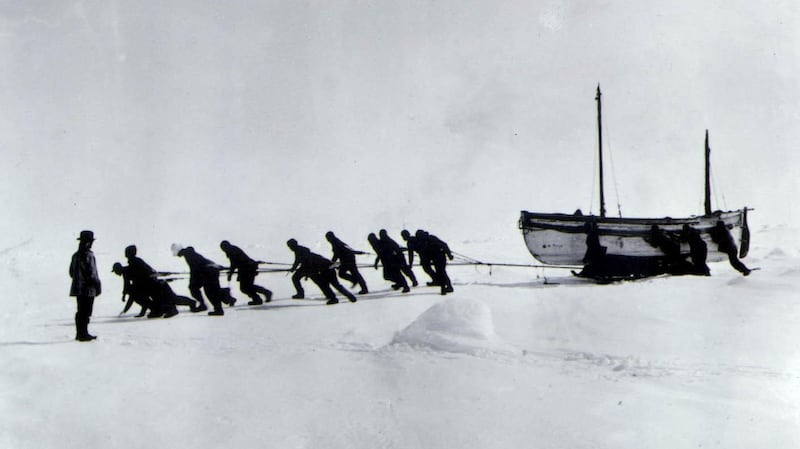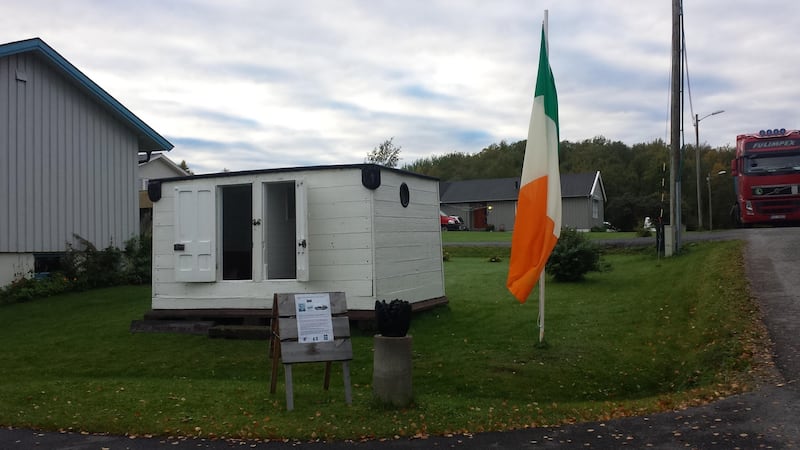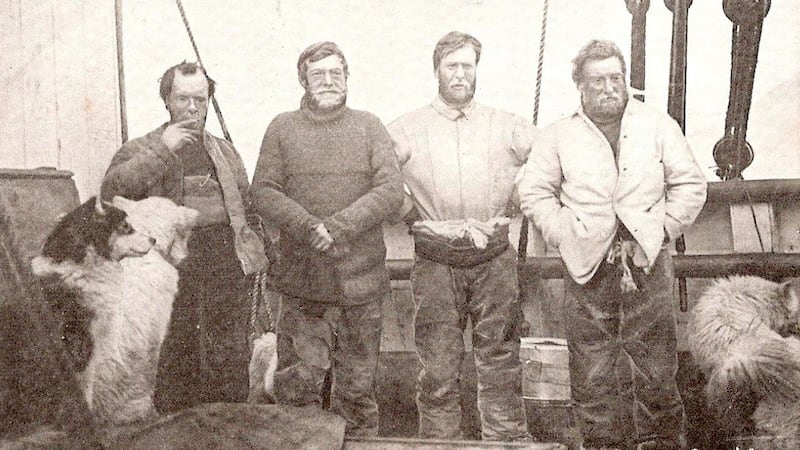Sven Habermann has taken delivery of many fine and fragile objects at his north Connemara workshop, and they come in all shapes, sizes, ages and condition.
Just outside his office, there’s a pair of late 19th-century Italian walnut doors, sent up from Leinster House for conservation. On a nearby table, there’s a set of antlers and skull once worn proudly by a giant deer, perhaps 10,000 years ago.
A delivery during autumn 2015 from northern Norway with far more recent provenance aroused such excitement that it attracted welcoming parties from Dublin. It looked like a garden shed – and, indeed, this was its official listing on the documentation examined by customs officers in Dublin Port. The century-old pitch pine structure had spent some decades as a Norwegian outhouse, but only after its first incarnation as a "sea-cabin" for polar explorer Sir Ernest Shackleton.


“I have had grown men cry when I showed them this,” Habermann says, holding out a doorknob which “the Boss”, as Shackleton was known,would have handled many times. Indeed, many a lump must have risen in the throats of those who have stepped into the tiny quarters where the Co Kildare-born adventurer breathed his last breath.
When you were in you felt half-afraid to draw a full breath in case you carried something away or bust the bulkhead apart
"Don't, please, carry away . . . an impression of sumptuous state-room," crewman Scout Marr said of the captain's cabin, which had been built on board the ship Quest for Shackleton's fourth expedition to the Antarctic, in 1921.
“This sea-bedroom was little better than a glorified packing case; it measured seven feet by six, and when you were in you felt half-afraid to draw a full breath in case you carried something away or bust the bulkhead apart,” Marr wrote.
Marr’s detailed description of the interior – the bunk stretching the entire room length, with drawers beneath and a single porthole above, along with a small washstand, shelves well-fitted with books, a small collapsible chair, and an emergency oil lamp – has proved invaluable for Habermann’s work.

The timber conservator who has managed Conservation Letterfrack for the past 17 years has been charged with preparing the cabin for eventual display after Norwegian Ulf Bakke donated it to the Athy Heritage Centre Museum. The museum has the only permanent exhibition dedicated to the explorer, and runs the annual Shackleton Autumn School, established to commemorate the explorer in the county of his birth.
As Habermann explains, Bakke's association with the cabin, and its journey to Ireland, is an adventure in itself. During childhood visits to his grandparents' farm above the Arctic Circle, Bakke would often be asked to go and fetch something from "the Shackleton" down the garden.
As he was to discover later, the “shed” was a section of the deck fixture attached to a Norwegian-built sealer which Shackleton had bought for his 1921 expedition. It had been rescued by his great-great grandfather when the ship eventually returned to Norway.
Shackleton had debts – a chronic condition– and so this low budget expedition aimed to clear them. However, the Quest was so small that a new deckhouse was added in Southampton to make extra cabin spaces, including the radio room and cabins for both captain and his second-in-command, Frank Wild.
The ship left St Katherine's docks in London on September 17th, 1921, and broke down several times during its journey south. In early January 1922, it anchored off the whaling station at Grytviken on South Georgia. It was here, backin 1916, that Shackleton and fellow exhausted and malnourished adventurers had sought help for their colleagues – stranded back on Elephant Island without a ship – after undertaking an epic 800-mile (1,500km) sea journey to raise the alarm.
From his diary entries while at Grytviken, Shackleton appears to have had some inkling of his mortality.
"Another beautiful day," he wrote on January 3rd, 1922. "Fortune seems to attend us this new year, but so anxious have I been when things are going well I wonder what in time difficulty will be sprung on me. All day long a light wind and clear sky was our happy position. I find a difficulty in settling down to write. I am so much on the qui vive (on the alert). I pray that the furnace will hold out . . ."
On January 4th, he recalled that struggle to arrive there four years before, and how “now we must speed all we can” from the “strange and curious place” where “the old smell of dead whale permeates everything”.
“A wonderful evening. In the darkening twilight I saw a lone star hover, gem like, above the bay,” he wrote.
Early on January 5th, he was attended to by his friend and expedition medical doctor, Alexander Macklin
Chiefly alcohol, boss, I don't think it agrees with you
“You’re always wanting me to give up things – what is it I ought to give up?” Shackleton asked from his bunk.
“Chiefly alcohol, boss, I don’t think it agrees with you,” Macklin recalled replying – and then there was silence.
After the "boss" was buried on South Georgia, the ship continued on its journey under the command of Frank Wild, calling into Elephant Island en route back to England that summer. In 1923 the vessel was sold to Ludolf Schelderup, a Norwegian sealer, and refitted in 1924 at the Rognan shipyard. The deckhouse was removed, taken ashore and split up for use as summerhouses and storage sheds.
Ulf's great-grandfather, shipyard-owner Johan Drage, took the Shackleton and Wild quarters back to his farm in Nordland. It was transported on a horse-drawn carriage to his farm at Saltdal near Rognan, where it was used to store equipment. At one point during the second World War, several Allied soldiers endeavouring to prevent the Germans crossing the Arctic Circle tried to shelter behind it when fired on; they were shot dead and were buried in the tiny Norwegian community, along with 24 Irish, Scottish and English colleagues.
Eventually the cabin passed to Ulf, who felt it was his duty to maintain it for historical purposes.
“It was built of very strong wood, and my grandfather took great care of the roof,” he told this newspaper. “My mother and uncle used it as a playhouse, and I remember that there were always photographs of ships inside it. It turned out that the fittings and the photographs were all original.”
In 1980, it was loaned to the local museum in Saltdalen, and was restored and opened to the public. Local schoolchildren would be invited to come and paint the cabin, and these many layers of paint form part of the conservator’s research into the original structure. As Habermann explains, Shackleton was, and is, held in high esteem in Norway because his attempt to become the first man to walk to the South Pole provided the route guides for Roald Amundsen in 1911.
He heard about the cabin, made a connection with Bakke, and the rest is recent history
In 2008, Corkman Eugene Furlong was in a pub on the Norwegian Lofoten islands, and got chatting about adventurers such as Nansen, Scott and close Shackleton associate, Kerryman Tom Crean. He heard about the cabin, made a connection with Bakke, and the rest is recent history.
Habermann has a close connection with the Athy Heritage Centre Museum, which sought his advice when Bakke’s offer was made.
“Our work is a mixture of art history, chemistry and craftsmanship, and we have to fully understand an object before we can touch it,” he says, explaining the approach of the six staff who work at Conservation Letterfrack.
The commercial company is situated next to, but independent of, Galway-Mayo Institute of Technology’s (GMIT) furniture design and wood technology centre. It was set up in 1999 as part of the busy Connemara West campus which was established as a community development company in 1971. The campus on the former St Joseph’s Industrial School also houses Connemara Community Radio and local development group Forum Connemara.
Two-thirds of Conservation Letterfrack's work is public, with much of it for the Office of Public Works. Clients have included Marsh's Library and Adare Manor in Co Limerick, and it recently restored all the wooden components for the National Gallery's historic interior.
Habermann admits he was sceptical at first about the state the cabin might be in. He travelled to north Norway in midsummer 2015 to check if it was stable enough to travel.
“Here was something made of pitch pine on steel frames that was taken off a boat in 1924 and had survived as a garden shed for a very long time,” he says. “However, the climate in this part of Norway is ultra-dry, with temperatures of minus 30 degrees in winter, and the cabin had been elevated with railway sleepers to protect it. I saw 100-year-old boats on the shore there which would have rotted here in a much shorter time because it is so much more humid and damp.”
Danish ferry company DFDS shipped it to Ireland, using the same trailer all the way to Letterfrack, accompanied by Athy Heritage Centre Museum committee member Joe O’Farrell.
“We were lucky that the chief executive of DFDS is a fellow polar enthusiast,” Habermann says. “At customs, the Norwegians just opened the gates, and everyone welcomed it.”
The work then began in Letterfrack to restore it to its original state. The bunk is original, but everything else has to be replicated.Old photos of its interior showed how it had been fitted out for Shackleton, with what looked like a “spud” on a side table – until Habermann realised it was probably an avocado plant, potted during one of the ship’s breakdowns.
“The cabin had wallpaper on its ceiling, and we even found the original design,” he says. Anaglypta 619, as it was called, had long been discontinued by its British manufacturer, Lincrusta. He contacted the company, and it went to endless lengths to trace the location of similar wallpaper to a house in London.
“Lincrusta took a silicon mould of it for us, and so we are able to recreate it. Of course, we will never know if there was a personal connection which influenced Shackleton’s decision to choose this wallpaper design,” Habermann says.
Samples of all sections of the cabin have been taken to confirm paint schemes and colours. Photos show that the cabin was painted white on the outside in London, and black on arrival in South Georgia. The names of Sir Ernest Shacketon and Commander Frank Wild are inscribed on silver plating over the two doors.
The porthole through which the captain could peer includes its original drip tray, to catch condensation
"Can you smell the wood tar," says Habermann, smiling as he describes how it transports him back to being a 10-year-old boy on a visit to the Fram museum in Oslo, built to house the famous ship used in Arctic and Antarctic expeditions by Norwegian explorers including Nansen and Amundsen.
Habermann points to where Shackleton’s bunk lies, and traces the holes where the oil lamp and its gimbal hung. The porthole through which the captain could peer includes its original drip tray, to catch condensation.
With funding from the Heritage Council and several grants from the National Lottery Good Causes Fund, he and his team will attend to every last little detail in time for the cabin's transfer to Athy. The final National Lottery grant of €10,000 should cover the conservation work.
Seamus Taaffe of the Athy Heritage Centre Museum explains that it has plans to extend its space, with support from Kildare County Council. The museum's exhibits include an original sledge and harness from Shackleton's Antarctic expeditions, and photos and film footage, with material recorded by Frank Hurley of the Endurance expedition. This more than makes a case for a dedicated floor, which will be designed to include an interpretation of the cabin's significance.
Taaffe’s colleague Joe O’Farrell can’t wait for that trip from Letterfrack to Kildare. “It’s not our style in Athy to blow our own trumpet, but we are still amazed and flabbergasted that we managed to acquire this unique item in the face of the stiffest of competition from all the world’s great polar institutions,” he says.
- Norwegian ambassador to Ireland Else Berit Eikeland is among speakers at the 17th annual Ernest Shackleton Autumn School in Athy, Co Kildare, which opens on Friday, October 27th and runs until October 30th. Its special daily exhibition from the Byrd Polar and Climate Research Centre focuses on Admiral Richard E Byrd's pioneering Antarctic expeditions between 1928 and 1935.
- For more details from the museum telephone 059-8633075 or athyheritagecentre-museum.ie









